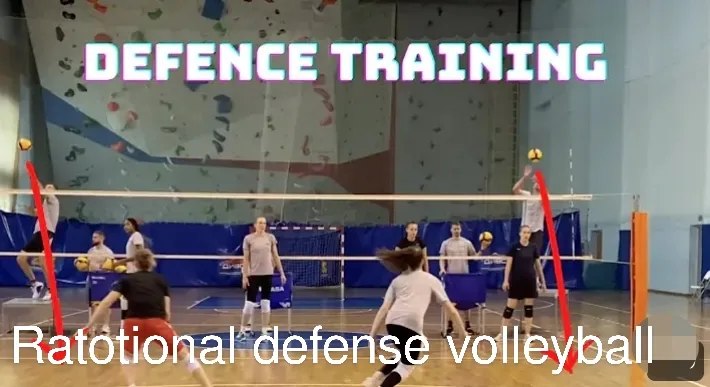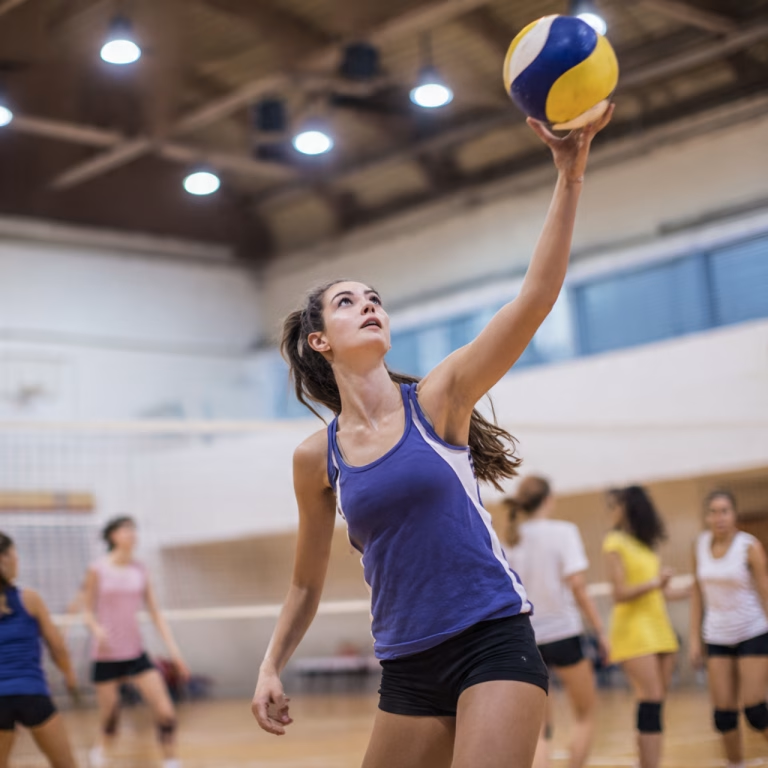Understanding rotational defense in volleyball is crucial for players and coaches aiming to enhance their defensive strategies. This guide will explain what rotational defense is, how to implement it effectively, and the key principles behind this common defensive system.
What is rotational defense in volleyball?
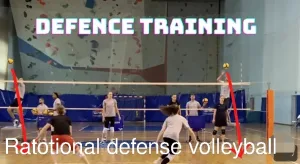
Rotational defense, also known as man-back defense, is a popular strategy used in women’s volleyball. The primary objective is to cover both tips and swings from the opposing team.
This strategy ensures that each player covers their assigned area, reducing the chances of gaps in the defense. Unlike other defensive strategies, rotational defense focuses on maintaining a consistent formation throughout the game.
This defensive setup ensures that players are optimally positioned to respond to various attacks.
See Also: How to Get Better at Volleyball: Practical Tips
Attacking Rotational Defense: Rotational defense in volleyball
To counter rotational defense, teams can employ specific attack strategies.
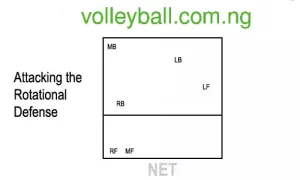
The diagrams below illustrate how to exploit this defensive system.
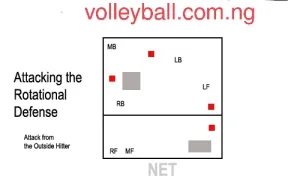
Gray and red markings on the graphics indicate optimal attack points. Gray spots suggest areas for tips or soft shots, while red spots highlight where to deliver powerful hits.
Tips for Defending the Outside Hitter
When defending a set to the outside hitter (attacker on the left side), the left-front blocker should rotate back from the net. Ideally, the blocker moves one step behind the 3-meter line and one step inside the sideline.
It is acceptable to concede the sharp-angle shot that lands inside the 3-meter line since such shots are less common. The focus should be on intercepting the likely flight path of the attack.
If the left-front blocker can effectively retreat from the net, the left-back player can drop back to cover the deeper cross-court shot. This cross-court attack is favored by many attackers. In rotational defense, the left-back typically concedes the deep corner shot. However, if the opponent consistently targets the corner, the left-back should adjust to intercept these hits.
Adapting Rotational Defense for Younger Players
For younger players, retreating behind the 3-meter line might be challenging, especially on quick sets to the outside. In such cases, taking large steps to retreat as far as possible is advisable. Straddling the 3-meter line can be an effective compromise.
Key Principles of Rotational Defense in Volleyball
The key principles of rotational defense involve movement, positioning, and teamwork. Each player has a defined role, whether it’s covering the backcourt or blocking at the net.
Effective communication is crucial in this system to ensure that players know their positions and responsibilities.
For example, in a 6-2 volleyball rotation defense, the team has two setters who switch between playing front row and back row, maintaining six attackers and two setters. This rotation ensures that the setters are always in the best position to set up the play while the attackers are ready to spike or block.
How to Implement Rotational Defense in Volleyball
Implementing rotational defense in volleyball requires practice and precision. Start by setting up the rotational positions on the court and assigning roles to each player. Drills that focus on movement and positioning will help players get accustomed to their roles.
For instance, a drill might involve practicing the “middle middle defense,” where the middle blocker moves to cover the center of the backcourt after a block attempt. Another drill could focus on “man-up defense,” where players practice man-to-man coverage during an opponent’s attack.
Benefits of rotational defense in volleyball
Rotational defense offers numerous benefits. It provides improved coverage, ensuring fewer gaps on the court. This system enhances player coordination, as each player knows their exact role and position. Additionally, rotational defense allows for greater flexibility and adaptability, making it easier to adjust to different offensive strategies from opponents.
Challenges of rotational defense in volleyball
While rotational defense has its advantages, it also comes with challenges. Proper execution requires discipline and precise movements. Adjusting to different offensive strategies can be difficult, especially if the team is not well-practiced in their roles. Maintaining consistency in this defense system demands constant communication and awareness from all players.
See Also:
- How to Get Better at Volleyball: Practical Tips
- Complete Guide to the Scoring System for Volleyball
- Volleyball Violations and Mistakes
- 10 Best Volleyball Strength Exercises for Beginners
- Pin Hitter Volleyball Position and Role Explained
FAQs
What is rotational defense in volleyball?
Rotational defense in volleyball is a strategy where players position themselves based on a rotational order, covering various areas of the court to defend against tips and swings.
How do you implement rotational defense effectively?
To implement rotational defense effectively, players must understand their roles and maintain precise positioning. Practicing specific drills and ensuring clear communication among team members are crucial.
What are common mistakes in rotational defense?
Common mistakes in rotational defense include poor communication, players failing to maintain their positions, and not adjusting to the opponent’s offensive strategies. Addressing these issues through regular practice and coordination is essential.
How does rotational defense compare to other defensive strategies?
Rotational defense provides improved coverage and coordination compared to other strategies like perimeter defense. It focuses on maintaining a consistent formation, making it easier to adjust to various offensive plays.
What are the benefits of rotational defense in volleyball?
Rotational defense offers enhanced coverage, improved player coordination, and greater flexibility. It helps teams respond effectively to different types of attacks and minimizes defensive gaps.
Understanding and mastering rotational defense in volleyball is essential for any team aiming to improve their defensive play. By focusing on positioning, teamwork, and effective communication, teams can enhance their ability to counter opponent attacks and maintain a strong defensive presence on the court.

